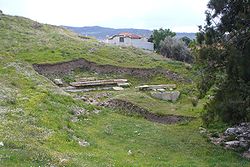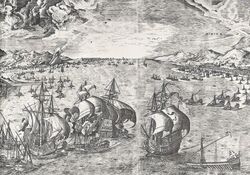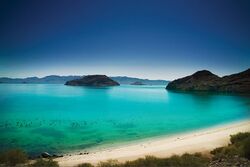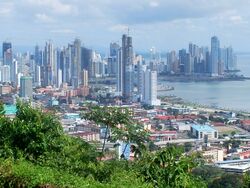Isles of Velar: Difference between revisions
mNo edit summary |
|||
| (10 intermediate revisions by the same user not shown) | |||
| Line 54: | Line 54: | ||
|established_event2 = Declaration of Divine Sovereignty | |established_event2 = Declaration of Divine Sovereignty | ||
|established_date2 = 17 May, 1064 | |established_date2 = 17 May, 1064 | ||
|established_event3 = Personal union with [[Trellin]] | |established_event3 = Personal union with [[Trellin]] | ||
|established_date3 = 1769 | |established_date3 = 1769 | ||
| Line 116: | Line 114: | ||
}} | }} | ||
'''Velar''' or the '''Isles of Velar''', officially the '''Kingdom of the Isles of Velar''' ([[ | '''Velar''' or the '''Isles of Velar''', officially the '''Kingdom of the Isles of Velar''' ([[Urbonic language|Urbonic]]: ''Risoí Synaxús Velarkon''; [[Trellinese language|Trellinese]]: ''Demrin Ethka Velari''), is a sovereign state and constituent nation of the [[Trellin|Trellinese Empire]], located in the [[Sea of Velar]] in western [[Astyria]]. Its landmass of {{convert|46206|sqkm|sqmi}} consists entirely of islands, of which twenty-seven are larger than {{convert|5|sqkm|sqmi}} and five larger than {{convert|100|sqkm|sqmi}} in area. | ||
The Isles of Velar are governed by [[ | The Isles of Velar are governed by [[Monarchy of the Isles of Velar|a constitutional monarchy]], originally established as an absolute monarchy in 1064 with the Declaration of Divine Sovereignty and reformed following a series of major uprisings in 1536. The country has been in personal [[War of the Velaran Succession|union with Trellin since 1769]] and it is often considered to be a part of Trellin, though strictly speaking it is only in the Trellinese Empire, not Trellin proper. Its current monarch, since 2015, is [[Azara V]]. The capital city is [[Parthenope]], on the island of [[Napocis]], and the largest city is [[Txir]] on [[Semeria]]. | ||
==Name== | ==Name== | ||
The name of the kingdom derives from its location in the Sea of Velar. From the | The name of the kingdom derives from its location in the Sea of Velar. From the thirteenth century, the country's name was styled as "the Kingdom of Velar", in reference to its conquests on the north shore of the Sea of Velar, but following the loss of these territories in the late eighteenth century it reverted to its original name. | ||
==History== | ==History== | ||
| Line 133: | Line 131: | ||
It was within this crusading context that, in 757, Ruzanel of Parthenope annexed the west Semerian duchy of [[Tumil]]. His son Szantir I, who succeeded him in 765, styled himself King of the Isles of Velar, to the anger of the [[Monarchy of Semeria|King of Semeria]], Nilzha of Borsem, who had been elected by the Semerian dukes as their king in 760. Szantir claimed that he and his father were dukes of Tumil and that their right to be electors of the Semerian king had been ignored; moreover, Szantir claimed the Semerian crown outright and made no attempt to hide his ambition to rule the entire archipelago. | It was within this crusading context that, in 757, Ruzanel of Parthenope annexed the west Semerian duchy of [[Tumil]]. His son Szantir I, who succeeded him in 765, styled himself King of the Isles of Velar, to the anger of the [[Monarchy of Semeria|King of Semeria]], Nilzha of Borsem, who had been elected by the Semerian dukes as their king in 760. Szantir claimed that he and his father were dukes of Tumil and that their right to be electors of the Semerian king had been ignored; moreover, Szantir claimed the Semerian crown outright and made no attempt to hide his ambition to rule the entire archipelago. | ||
Nilzha and Szantir quickly came to blows, and the Parthenopeans were opposed by an alliance of Borsem, Aidemó and Petiqi. Aidemó lost substantial territory to Szantir, but he failed to wrest the crown from Nilzha. Szantir made further gains in subsequent wars with other duchies, exacting tribute from Petiqi in 784 and 792 and forcing the submission of Txenrokú in 801. In 812, Nilzha died, and an election was convened at [[Mayua]], where traditionally the Semerian dukes elected their overlord. Szantir advanced his cause at this election, but it was repudiated on two main counts: the other electors, although they had conceded that Tumil had a vote, refused to allow a non-Semerian to be their king, especially as he was a Christian. Szantir presented himself to the Mayuan Oracle regardless, and she turned him away. The dukes elected the young Likanton of | Nilzha and Szantir quickly came to blows, and the Parthenopeans were opposed by an alliance of Borsem, Aidemó and Petiqi. Aidemó lost substantial territory to Szantir, but he failed to wrest the crown from Nilzha. Szantir made further gains in subsequent wars with other duchies, exacting tribute from Petiqi in 784 and 792 and forcing the submission of Txenrokú in 801. In 812, Nilzha died, and an election was convened at [[Mayua]], where traditionally the Semerian dukes elected their overlord. Szantir advanced his cause at this election, but it was repudiated on two main counts: the other electors, although they had conceded that Tumil had a vote, refused to allow a non-Semerian to be their king, especially as he was a Christian. Szantir presented himself to the [[Mayuan Oracle]] regardless, and she turned him away. The dukes elected the young [[Likanton of Txir]] as their overlord instead. | ||
Szantir returned to Mayua with an army later that year; the mountaintop city resisted the lengthy siege, but ultimately it was betrayed from within and Mayua was pillaged. The temple of the oracle was destroyed, although it was believed the Oracle herself escaped. Szantir died in 816, but his successors proved no more open to compromise than he had been, and the slow conquest of Semeria continued. Likanton led a protracted resistance but could not overcome the Parthenopeans. In 847, he appealed to the Prince of Mora'ika for help, and the resulting alliance engaged the Parthenopean army at the Battle of Tarm Dolen, near Txir, where it was completely destroyed as a result of a series of miscommunications and poor manoeuvres. This victory left the Kingdom of Parthenope, now barely opposed as the Kingdom of the Isles of Velar, the most powerful nation in the sea, and it began to spread its dominance to the mainlands by colonisation. In the early 900s it conquered the [[County of Pelna]] and began making incursions into [[Principality of Retikh|Retikan]] territories. | Szantir returned to Mayua with an army later that year; the mountaintop city resisted the lengthy siege, but ultimately it was betrayed from within and Mayua was pillaged. The temple of the oracle was destroyed, although it was believed the Oracle herself escaped. Szantir died in 816, but his successors proved no more open to compromise than he had been, and the slow conquest of Semeria continued. Likanton led a protracted resistance but could not overcome the Parthenopeans. In 847, he appealed to the Prince of Mora'ika for help, and the resulting alliance engaged the Parthenopean army at the Battle of Tarm Dolen, near Txir, where it was completely destroyed as a result of a series of miscommunications and poor manoeuvres. This victory left the Kingdom of Parthenope, now barely opposed as the Kingdom of the Isles of Velar, the most powerful nation in the sea, and it began to spread its dominance to the mainlands by colonisation. In the early 900s it conquered the [[County of Pelna]] and began making incursions into [[Principality of Retikh|Retikan]] territories. | ||
| Line 139: | Line 137: | ||
[[File:Battle of Mintra.jpg|thumb|left|250px|''The Battle at Mintra'', commissioned by King Damos of Velar in 1512]] | [[File:Battle of Mintra.jpg|thumb|left|250px|''The Battle at Mintra'', commissioned by King Damos of Velar in 1512]] | ||
As the Kingdom of Velar attempted to expand along the coasts, other nations in the eastern sea looked on with growing unease. The two most powerful, the [[Principality of Txekrikar]] and the [[Grand Duchy of Ja'ekha]], supported by a number of smaller states, entered into a pact against the Velarans in 976. This pact, the Coalition of the East, regularly blocked Velar's attempts at expansion, and, though the numbers of the smaller supporters changed over time, the two central members remained more than a match for Velar on land and often had the manpower to defeat them at sea. From the 1200s on, the Coalition was sponsored by the merchants of [[Mintra]], a Trellinese [[Trophy Ports|Trophy Port]] in the eastern sea which aimed to dominate maritime trade in the region. There were frequent wars, the most disastrous of which culminated in 1481 with the Battle of Mintra, at which nearly two hundred Velaran galleys engaged and destroyed a larger Txekri and Ja'ekhan fleet before going on to sack the port in revenge. | As the Kingdom of Velar attempted to expand along the coasts, other nations in the eastern sea looked on with growing unease. The two most powerful, the [[Principality of Txekrikar]] and the [[Grand Duchy of Ja'ekha]], supported by a number of smaller states, entered into a pact against the Velarans in 976. This pact, the Coalition of the East, regularly blocked Velar's attempts at expansion, and, though the numbers of the smaller supporters changed over time, the two central members remained more than a match for Velar on land and often had the manpower to defeat them at sea. From the 1200s on, the Coalition was sponsored by the merchants of [[Mintra]], a Trellinese [[Trophy Ports|Trophy Port]] in the eastern sea which aimed to dominate maritime trade in the region. There were frequent wars, the most disastrous of which culminated in 1481 with the Battle of Mintra, at which nearly two hundred Velaran galleys engaged and destroyed a larger Txekri and Ja'ekhan fleet before going on to sack the port in revenge. | ||
The sack of Mintra aroused the ire of the Trellinese Empire, and in 1487 a vast navy was sent out by King Perendur to retaliate against Velar. It destroyed the port of Parthenope before the Velarans had time to assemble their fleets, and the Velaran navy found itself forced to retreat before their larger foe. Storms and minor skirmishes slowly wore down the Trellinese fleet, and they turned north to attack the colonies along the coast of the mainland. Aware that their islands were now safe but unable to attack the Trellinese, the King of Velar agreed to concessions of much of the coast of Pelna and Retikh. Though they continued to colonise in Rezat and | |||
The sack of Mintra aroused the ire of the Trellinese Empire, and in 1487 a vast navy was sent out by King Perendur to retaliate against Velar. It destroyed the port of Parthenope before the Velarans had time to assemble their fleets, and the Velaran navy found itself forced to retreat before their larger foe. Storms and minor skirmishes slowly wore down the Trellinese fleet, and they turned north to attack the colonies along the coast of the mainland. Aware that their islands were now safe but unable to attack the Trellinese, the King of Velar agreed to concessions of much of the coast of Pelna and Retikh. Though they continued to colonise in Rezat and Mëhidan, the kingdom's northern possessions were whittled away over the following centuries by Trellinese and Ja'ekhan conquests. | |||
===Early modern era=== | ===Early modern era=== | ||
The | The sixteenth century onward saw the beginning of the long decline of Velar, and in just two centuries it saw the loss of most of its land north of the Pelnan coast, though it retained a broad strip including the major cities of [[Zarthalin]], [[Radulin]] and Konoros. As its military strength declined, it found itself consorting with its historic rivals in Trellin. In 1737, its young queen, [[Tarien, Queen of the Isles of Velar|Tarien]], married [[Elcmar IV|Elcmar, Duke of Palaegon]] who two years later was crowned [[Monarchy of Trellin|King of Trellin]]. Tarien died suddenly in 1769, sparking fears among the Velaran nobility that, if Elcmar succeeded her, he would name the [[Azara IV|daughter of his first marriage]] as his heir to both kingdoms; consequently, they chose a rival candidate for the throne, [[Prince Miró of Txir]], and began the [[War of the Velaran Succession]] to protect their monarchy from foreign rule. Velar was at a disadvantage from the outset, but fought a strong resistance to the Trellinese, [[Arimathea]]n and Ja'ekhan coalition that formed against them. After the [[Siege of Teyra]], Miró capitulated and recognised Elcmar's accession to the throne. | ||
===Modern history=== | |||
The War of the Velaran Succession left the country devastated. Its trade had been stifled for two years; much of the land lay fallow or barren; and many of its men had been killed. It was now additionally deprived of its prosperous holdings in Pelna and Retikh. Although the Trellinese and crown invested heavily in maintaining the Velaran state apparatus, this was not matched with funds to rebuild the ravaged economy. [[Azara IV's Edicts of Amnesty|Azara IV's amnesty]] granted to the majority of Miróist rebels did little to stem the flow of emigrants. Many of the minor nobility in particular left the country, travelling to Trellin, [[Nikolia]] and further afield. Velar's economic development would lag behind Trellin's for the next two centuries, compounded by Velar's forced dependence on Trellinese trade. | |||
When, in 1913, [[Amadar IV]] issued the Edict of Isolation in Trellin and Hysera, he proposed to bring Velar into isolation with the rest of the empire. In reality, the Velaran parliament had little choice: were they to reject the proposal, they would find themselves unable to trade with their most important partner. Reluctantly, they passed the necessary legislation. | |||
==Geography== | ==Geography== | ||
[[File:Gar Ersa'i, Adazakh.jpg|thumb|left|250px|Islands in [[Adazakh]]'s | [[File:Gar Ersa'i, Adazakh.jpg|thumb|left|250px|Islands in [[Adazakh]]'s [[Bay of Ersa]]]] | ||
Major islands: | Major islands: | ||
| Line 152: | Line 156: | ||
* Tavlar: 863.44 sq. km | * Tavlar: 863.44 sq. km | ||
* [[Semeria]]: 20,612.62 sq. km | * [[Semeria]]: 20,612.62 sq. km | ||
[[File:Tymfiwestface.jpg|thumb|right|250px|[[Mai-esu Fanonú]], the highest mountain in the archipelago, lies in the northeast of Semeria's [[Nero Semeriakon]]]] | |||
There are mountains on the different islands, e.g. the [[Nero Semeriakon]], which forms a spine running the length of the island of Semeria | |||
===Climate=== | ===Climate=== | ||
Latest revision as of 03:24, 1 August 2024
This article is incomplete because it is pending further input from participants, or it is a work-in-progress by one author. Please comment on this article's talk page to share your input, comments and questions. Note: To contribute to this article, you may need to seek help from the author(s) of this page. |
Kingdom of the Isles of Velar | |
|---|---|
|
Flag | |
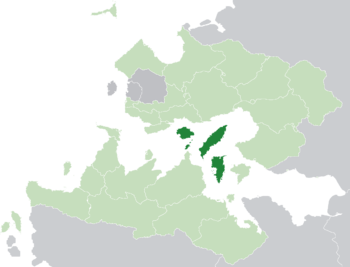 Location of the Isles of Velar (dark green) in the Trellinese Empire (light green) | |
| Capital | Parthenope |
| Largest city | Txir |
| Official languages | Trellinese, Urbont |
| Ethnic groups (2013) | 82.5% Velaric 8.4% Txekri 9.1% others |
| Demonym(s) | Velaran |
| Government | Unitary constitutional monarchy |
• Queen | Azara V |
| Establishment | |
• Foundation | 765 |
• Declaration of Divine Sovereignty | 17 May, 1064 |
• Personal union with Trellin | 1769 |
| Area | |
• Total | 46,206.43 km2 (17,840.40 sq mi) |
| Population | |
• 2013 census | 8,755,823 |
• Density | 189/km2 (489.5/sq mi) |
| Currency | Rasna (Ʀ) (TRS) |
| Time zone | UTC−1 (TCT) |
| Date format | dd/mm/yyyy |
| Driving side | left |
| Calling code | +87585 |
| Internet TLD | .sv |
Velar or the Isles of Velar, officially the Kingdom of the Isles of Velar (Urbonic: Risoí Synaxús Velarkon; Trellinese: Demrin Ethka Velari), is a sovereign state and constituent nation of the Trellinese Empire, located in the Sea of Velar in western Astyria. Its landmass of 46,206 square kilometres (17,840 sq mi) consists entirely of islands, of which twenty-seven are larger than 5 square kilometres (1.9 sq mi) and five larger than 100 square kilometres (39 sq mi) in area.
The Isles of Velar are governed by a constitutional monarchy, originally established as an absolute monarchy in 1064 with the Declaration of Divine Sovereignty and reformed following a series of major uprisings in 1536. The country has been in personal union with Trellin since 1769 and it is often considered to be a part of Trellin, though strictly speaking it is only in the Trellinese Empire, not Trellin proper. Its current monarch, since 2015, is Azara V. The capital city is Parthenope, on the island of Napocis, and the largest city is Txir on Semeria.
Name
The name of the kingdom derives from its location in the Sea of Velar. From the thirteenth century, the country's name was styled as "the Kingdom of Velar", in reference to its conquests on the north shore of the Sea of Velar, but following the loss of these territories in the late eighteenth century it reverted to its original name.
History
Prehistory
The Velaric culture was one of the first major civilisations to rise in modern Trellin and the Sea of Velar, starting out as small fishing villages around the isles and slowly shifting towards a trading people. By the start of the fifth century BC, the sea was criss-crossed by the trade routes of prosperous Velaric city-states which held shifting allegiances. In contrast to their western counterparts, the eastern Velaric states turned to coastal raiding, waging war on the Perenden civilisation of Andamonia. Baxa was later colonised by the Perendi in their efforts to destroy the Velaric threat.
Middle ages
The Kingdom of Parthenope converted to Christianity in the mid-seventh century, the first major Velaran state to do so. This sparked controversy which saw Parthenope ostracised by its peers and frequent wars between it and them. The Parthenopean kingdom adopted Christian motifs and imagery in its military and underwent a major cultural shift in the following decades, increasingly seeing itself as the ordained rival of its eastern neighbours.
It was within this crusading context that, in 757, Ruzanel of Parthenope annexed the west Semerian duchy of Tumil. His son Szantir I, who succeeded him in 765, styled himself King of the Isles of Velar, to the anger of the King of Semeria, Nilzha of Borsem, who had been elected by the Semerian dukes as their king in 760. Szantir claimed that he and his father were dukes of Tumil and that their right to be electors of the Semerian king had been ignored; moreover, Szantir claimed the Semerian crown outright and made no attempt to hide his ambition to rule the entire archipelago.
Nilzha and Szantir quickly came to blows, and the Parthenopeans were opposed by an alliance of Borsem, Aidemó and Petiqi. Aidemó lost substantial territory to Szantir, but he failed to wrest the crown from Nilzha. Szantir made further gains in subsequent wars with other duchies, exacting tribute from Petiqi in 784 and 792 and forcing the submission of Txenrokú in 801. In 812, Nilzha died, and an election was convened at Mayua, where traditionally the Semerian dukes elected their overlord. Szantir advanced his cause at this election, but it was repudiated on two main counts: the other electors, although they had conceded that Tumil had a vote, refused to allow a non-Semerian to be their king, especially as he was a Christian. Szantir presented himself to the Mayuan Oracle regardless, and she turned him away. The dukes elected the young Likanton of Txir as their overlord instead.
Szantir returned to Mayua with an army later that year; the mountaintop city resisted the lengthy siege, but ultimately it was betrayed from within and Mayua was pillaged. The temple of the oracle was destroyed, although it was believed the Oracle herself escaped. Szantir died in 816, but his successors proved no more open to compromise than he had been, and the slow conquest of Semeria continued. Likanton led a protracted resistance but could not overcome the Parthenopeans. In 847, he appealed to the Prince of Mora'ika for help, and the resulting alliance engaged the Parthenopean army at the Battle of Tarm Dolen, near Txir, where it was completely destroyed as a result of a series of miscommunications and poor manoeuvres. This victory left the Kingdom of Parthenope, now barely opposed as the Kingdom of the Isles of Velar, the most powerful nation in the sea, and it began to spread its dominance to the mainlands by colonisation. In the early 900s it conquered the County of Pelna and began making incursions into Retikan territories.
As the Kingdom of Velar attempted to expand along the coasts, other nations in the eastern sea looked on with growing unease. The two most powerful, the Principality of Txekrikar and the Grand Duchy of Ja'ekha, supported by a number of smaller states, entered into a pact against the Velarans in 976. This pact, the Coalition of the East, regularly blocked Velar's attempts at expansion, and, though the numbers of the smaller supporters changed over time, the two central members remained more than a match for Velar on land and often had the manpower to defeat them at sea. From the 1200s on, the Coalition was sponsored by the merchants of Mintra, a Trellinese Trophy Port in the eastern sea which aimed to dominate maritime trade in the region. There were frequent wars, the most disastrous of which culminated in 1481 with the Battle of Mintra, at which nearly two hundred Velaran galleys engaged and destroyed a larger Txekri and Ja'ekhan fleet before going on to sack the port in revenge.
The sack of Mintra aroused the ire of the Trellinese Empire, and in 1487 a vast navy was sent out by King Perendur to retaliate against Velar. It destroyed the port of Parthenope before the Velarans had time to assemble their fleets, and the Velaran navy found itself forced to retreat before their larger foe. Storms and minor skirmishes slowly wore down the Trellinese fleet, and they turned north to attack the colonies along the coast of the mainland. Aware that their islands were now safe but unable to attack the Trellinese, the King of Velar agreed to concessions of much of the coast of Pelna and Retikh. Though they continued to colonise in Rezat and Mëhidan, the kingdom's northern possessions were whittled away over the following centuries by Trellinese and Ja'ekhan conquests.
Early modern era
The sixteenth century onward saw the beginning of the long decline of Velar, and in just two centuries it saw the loss of most of its land north of the Pelnan coast, though it retained a broad strip including the major cities of Zarthalin, Radulin and Konoros. As its military strength declined, it found itself consorting with its historic rivals in Trellin. In 1737, its young queen, Tarien, married Elcmar, Duke of Palaegon who two years later was crowned King of Trellin. Tarien died suddenly in 1769, sparking fears among the Velaran nobility that, if Elcmar succeeded her, he would name the daughter of his first marriage as his heir to both kingdoms; consequently, they chose a rival candidate for the throne, Prince Miró of Txir, and began the War of the Velaran Succession to protect their monarchy from foreign rule. Velar was at a disadvantage from the outset, but fought a strong resistance to the Trellinese, Arimathean and Ja'ekhan coalition that formed against them. After the Siege of Teyra, Miró capitulated and recognised Elcmar's accession to the throne.
Modern history
The War of the Velaran Succession left the country devastated. Its trade had been stifled for two years; much of the land lay fallow or barren; and many of its men had been killed. It was now additionally deprived of its prosperous holdings in Pelna and Retikh. Although the Trellinese and crown invested heavily in maintaining the Velaran state apparatus, this was not matched with funds to rebuild the ravaged economy. Azara IV's amnesty granted to the majority of Miróist rebels did little to stem the flow of emigrants. Many of the minor nobility in particular left the country, travelling to Trellin, Nikolia and further afield. Velar's economic development would lag behind Trellin's for the next two centuries, compounded by Velar's forced dependence on Trellinese trade.
When, in 1913, Amadar IV issued the Edict of Isolation in Trellin and Hysera, he proposed to bring Velar into isolation with the rest of the empire. In reality, the Velaran parliament had little choice: were they to reject the proposal, they would find themselves unable to trade with their most important partner. Reluctantly, they passed the necessary legislation.
Geography
Major islands:

There are mountains on the different islands, e.g. the Nero Semeriakon, which forms a spine running the length of the island of Semeria

